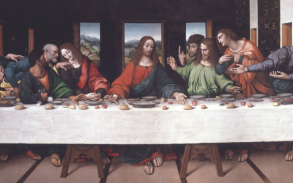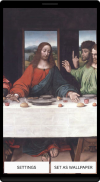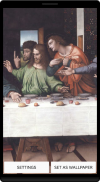





The Last Supper Live Wallpaper

Beschreibung von The Last Supper Live Wallpaper
The Last Supper (Italian: Il Cenacolo [il tʃeˈnaːkolo] or L'Ultima Cena [ˈlultima ˈtʃeːna]) is a late 15th-century mural painting by Leonardo da Vinci in the refectory of the Convent of Santa Maria delle Grazie, Milan. It is one of the world's most famous paintings.
The work is presumed to have been commenced around 1495 and was commissioned as part of a plan of renovations to the church and its convent buildings by Leonardo's patron Ludovico Sforza, Duke of Milan. The painting represents the scene of The Last Supper of Jesus with his disciples, as it is told in the Gospel of John, 13:21. Leonardo has depicted the consternation that occurred among the Twelve Disciples when Jesus announced that one of them would betray him.
Due to the methods used, and a variety of environmental factors, as well as intentional damage, very little of the original painting remains today, despite numerous restoration attempts, the last being completed in 1999.
Das letzte Abendmahl (italienisch: Il Cenacolo [il tʃenaːkolo] oder L'Ultima Cena [lultima tʃeːna]) ist ein Ende des 15. Jahrhunderts Wandmalerei von Leonardo da Vinci im Refektorium des Klosters von Santa Maria delle Grazie in Mailand. Es ist eines der berühmtesten Gemälde der Welt.
Die Arbeit wird dann angenommen, haben sich um 1495 begonnen worden und wurde als Teil eines Plans der Renovierungsarbeiten an der Kirche und ihrer Klostergebäude von Leonardo Patron Ludovico Sforza, Herzog von Mailand in Auftrag gegeben. Das Gemälde stellt die Szene des letzten Abendmahls Jesu mit seinen Jüngern, wie es im Evangelium des Johannes, 13.21 erzählt wird. Leonardo hat die Betroffenheit gezeigt, dass unter den zwölf Jünger trat auf, als Jesus bekannt, dass einer von ihnen ihn verraten würde.
Aufgrund der verwendeten Methoden und eine Vielzahl von Umweltfaktoren sowie vorsätzliche Beschädigung, nur sehr wenig von der ursprünglichen Malerei bleibt heute trotz zahlreicher Restaurierungsversuche im Jahr 1999 das letzte Wesen abgeschlossen.

























